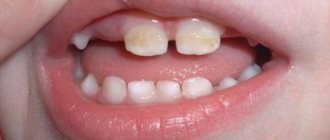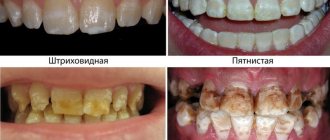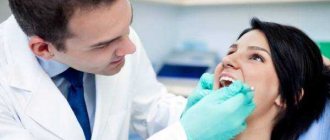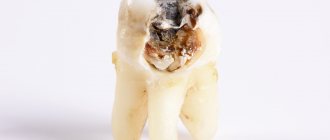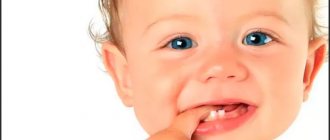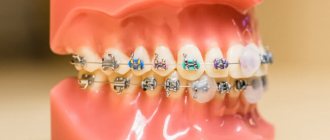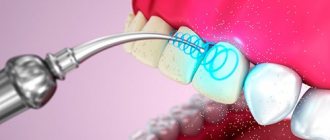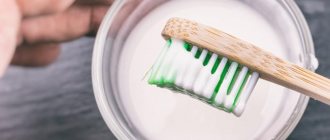The process of tooth movement
The fact that teeth have returned to their original position after wearing braces, unfortunately, occurs in many patients. Let’s look at the reasons for this problem and find out how teeth behave during the treatment process.
Braces aim to straighten teeth by applying a certain amount of pressure to them. This moves the tooth in the desired direction. However, a tooth is just one unit of a rather complex jaw system. Its root is located in the jaw bone, surrounded by bone tissue. In this case, the root and bone tissue have a certain space between them - the periodontal gap. It contains nerves, blood vessels and ligaments to nourish and hold the tooth.
When a tooth moves, under the influence of the leveling system, the bone tissue liquefies. In such a situation, nerves and blood vessels are forced to rebuild. The place where the tooth was originally located is vacated and is overgrown with bone tissue. Throughout the treatment, the ligaments holding the tooth are stretched. But they are very elastic, and when the teeth are freed from braces, they tend to their original shape. And the new bone tissue that appears in the place vacated by the tooth is still quite weak, because to fully strengthen it, it takes from several months to several years, depending on the characteristics of the patient’s body. For this reason, teeth may move apart.
A patient whose braces have been removed is prescribed by a doctor to wear retainers. Which are put on the inside of the dentition for a period determined by the doctor. This is how the result achieved with braces is secured.
Why do teeth shift?
- partial edentia: if there is a free hole in a row, adjacent teeth will begin to move closer to the free space. The tight connection of the teeth with each other provides stable support for all elements in the row, thanks to which they maintain the correct position throughout life,
- bone atrophy: as a result of tooth root removal, the bone tissue is deprived of the necessary load, which triggers the process of its atrophy. All this leads to displacement of the teeth, which is a consequence of the uneven distribution of bone tissue volumes along the row,
Displacement after tooth extraction - growth of the last molars: the outermost teeth, also known as “wisdom teeth,” erupt incorrectly in 98% of cases and therefore often need to be removed1. When they appear, strong pressure is created on the entire row and, accordingly, displacement often occurs. As a result, even an adult who does not have any dental problems may experience crowding when the teeth begin to “climb” on top of each other,
- Bite defects: if the rows are incorrectly positioned, excessive mobility is often observed.
Removable products
Using mouthguards after braces for the first time means wearing them constantly and removing them only during meals. Then you can put on the mouthguards only at night. If a positive result of fixing the position of the teeth is already visible, the orthodontist may prescribe their use every other day.
The aligners may be clear or have a tint resembling enamel. The products are put on one jaw or two at once, depending on the type of mouthguard. You can also insert metal wire into them, which will increase the rigidity effect and prevent deformation.
Caring for the mouth guards is quite simple. They are treated with paste and rinsed with running water. The advantages of these products:
- convenient to use;
- easy to clean;
- the ability to remove them if necessary.
Minuses:
- products are noticeable on the teeth;
- may cause speech impairment;
- cause a lot of salivation.
Some patients are unable to wear mouth guards due to an allergy to the plastic or irritation.
Fixed products
Fixed retainers are a fairly rigid wire that is secured with a special glue to the back of the teeth. The installation can only be performed by an orthodontist.
Such structures can be installed before removing the bracket system, or immediately after it. Before the procedure, it is important to prepare the oral cavity and clean it from plaque and tartar.
It doesn't take long to get used to such retainers. This will take a maximum of a week. And their main advantage is that they are invisible to others.
Other advantages of the products:
- they cannot be lost;
- act on the teeth continuously;
- do not cause discomfort.
Negative points:
- difficulty of oral hygiene;
- the need for constant visits to the doctor;
- there is a risk of peeling off.
There are cases when different retainers are used in combination. For example, fixed ones are for the upper jaw, and removable ones are for the lower jaw.
Why do teeth fall out
The causes of edentulism are very different:
- Trauma - a tooth may fall out directly during or some time after it. In the latter case, it is important to promptly contact a dentist or maxillofacial surgeon.
- Periodontitis, periodontal disease is a pathological inflammation and destruction of periodontal tissues, which leads to loss of root support with subsequent loss of often a completely healthy tooth.
- Caries - edentulism occurs with an advanced form of deep caries, when the destruction of dentin reaches the pulp, and the infection reaches the root zone.
- Malocclusion – constant tension and pressure over time can destroy the retaining tissues of the periodontium and provoke looseness, and then tooth loss.
- Subgingival abscesses - inflammation in the immediate vicinity of the periodontium can lead to loss of stability of the tooth root.
- Circulatory disorders and poor nutrition of gingival tissues can cause atrophy and necrosis of hard tissues.
On a note! A rare but possible option is tooth loss in adults due to a delayed change of milk rows. Such an anomaly is possible when the tooth germs are deeply buried, as well as in protracted diseases with delayed development of the entire organism. Such cases are not unique; one of them is recorded in the historical chronicle and is associated with the most odious ruler of Rus' - Ivan the Terrible. Both the chronicles and subsequent studies by anthropologists show that his milk teeth were replaced by permanent ones only at the age of 35-40 years.
At risk are:
- patients with chronic diseases - diabetes mellitus, thyroid pathologies, vascular disorders, autoimmune diseases (rheumatoid arthritis), osteoporosis, anemia, chronic hypertension, etc.;
- people exposed to frequent and prolonged nervous stress;
- smokers with experience - smoking negatively affects a person’s overall health, disrupts the functioning of the immune system and impairs blood microcirculation, including in the vessels that nourish the gum tissue;
- pregnant women - hormonal changes in the body weaken the immune system, and the increased growth of the new organism takes over a significant part of the vitamins and microelements;
- fans of hazardous sports;
- cancer patients, especially during radiation therapy.
Causes of tooth loss in children
If teeth fall out as planned at the age of 5–12 years, this is an absolutely physiological process. It takes place according to the natural genetic program of the Homo sapiens organism. At the same time, the roots of the baby teeth, supported by the crowns of the permanent teeth growing to replace them, begin to dissolve, and the tooth, losing its connection with the bone tissue, falls out.
However, children can also experience pathological loss of 1 or more teeth:
- Losing a baby tooth too early can be the result of injury, advanced caries or a hereditary disease. Parents are calm about this phenomenon, believing that “new ones will grow anyway,” but this can provoke unpleasant consequences in the form of malocclusion and dystopia of permanent teeth.
- Loss of newly grown molars. The main reason is chronic diseases and a serious lack of vitamins and minerals in the body. In conditions of active growth of the child’s body, the lack of resources for the formation of bone tissue negatively affects the condition of the teeth. In addition, some common causes of tooth loss remain relevant - trauma, caries (children do not like to take care of their hygiene), and malocclusion.
What to do if your teeth become crooked after braces are removed?
Retainers help prevent teeth from becoming crooked after braces are completed. Thin metal wire does not allow teeth to change their acquired appearance, securing the result of treatment.
The use of aligners is also a method to return teeth to their place. If serious complications occur, you may have to reinstall the braces system. Therefore, a patient who notices tooth displacement after braces should contact his doctor as soon as possible, so the correction will be easier and more effective. Teeth shifting is quite normal, and if retainers or mouth guards are not used after removal, this is likely to occur. There are cases when a retainer was immediately installed, but the teeth still moved apart. This means that the design does not work due to its incorrect installation.
Most often, all the blame for the fact that the teeth have moved apart lies on the shoulders of the patient, who, having received a perfect smile and tired of braces, stopped paying due attention to the oral cavity and did not follow the doctor’s recommendations.
After removing the braces, the doctor examines the results obtained and recommends one or another method of correction.
How braces treatment ruined my life. TMJ dysfunction and what I experienced.
Every time I receive messages in a personal message about unpleasant consequences after treatment with braces . And I was ready to publish an article about my experience of treatment with braces , but recently I again received a message from a girl, which not only shocked me, but also encouraged me to write about her story first.
We corresponded with her for a long time and she gave me permission to publish her treatment path with the help of braces, naturally anonymously. So, read carefully and draw your own conclusions. At the end of the article there will be my subjective opinion.
I also decided to share my not at all short life story with a diagnosis of TMJ dysfunction , which I have been suffering from since 2010, that is, for about 10 years. For a very long time I wanted to tell about everything that I had to go through, but until now I didn’t think that there were people for whom this could be useful or interesting, people with the same advanced or similar case. I actually thought that I was just an exception or a system error that happens once every 100 years. I’m still not sure whether my story will be useful to anyone at all, whether anyone will read it and what the reaction will be to it. After all, everyone to whom I have ever told how much my braces laughed at me. This still happens today. When I talk about the consequences of my orthodontic treatment that I had to face, even orthodontists just shrug their shoulders, cutting off more than half of the symptoms, citing the fact that their connection with TMJ dysfunction has not been proven, especially with regard to the patient’s loss of balance. They most often only suggest looking for their cause in another deviation. I was so used to misunderstanding that I left this problem and life with it to myself. It doesn’t exist for the people around me, it exists only for me, and it’s as if I’m a prisoner of my own body, while actually living in freedom. When I occasionally remind my family that I may one day be able to fully recover from TMJ dysfunction , I hear in response: “You’re with your teeth again! Calm down, everything is fine with you!” But in reality there is nothing good! This is not the life I had before! I can only remember with regret what quality of life I had before orthodontic treatment . Everything was divided into before and after.
But I wouldn’t want everyone who finds themselves in my situation to do this! I think that you can’t leave this problem to yourself, you need to try to get out of it until the very end, until you fully recover, and not despair. And then, quite by accident, I came across an article: https://zub-za-zub.ru/tmj/danger_of_braces/. In it, for the first time in 10 years, I finally read about scientific research by doctors about the impact that braces on the skull, neck area, spine and human health. Having found a forum of people suffering from the same diagnosis, I realized that I simply could not remain silent, so forgive me for the sentimental wave of thoughts in advance! I tried to compose this letter, conveying as much as possible all my feelings, listing everything that I felt myself. But not to complain or to feel sorry for me, because I have already learned to live with this without any support or understanding at all, and for quite a long time. But I believe that perhaps another person diagnosed with TMJ dysfunction will be able to “learn from” my story and this will help him get on the right path of treatment.
This was my state of affairs. In 2008 (at the age of 18), I was fitted with a simple metal brace system in the most ordinary children's clinic (in St. Petersburg), on the advice of a classmate who was successfully treated there. I was attracted by the price, because at that time there was no money for expensive treatment. I had an incorrect bite , crowded teeth , especially in the upper jaw (looking ahead, I’ll say that it seemed to me that it was crowding that most often leads to the same consequences as mine). Aesthetically, of course, it was not beautiful, my front teeth overlapped one another, I was ashamed to smile and even show myself to the dentist during a routine examination.
At the same time, I did not remove a single tooth during the treatment, incl. wisdom teeth I wore the system on my upper jaw for about a year and absolutely everything went smoothly, there was no pain (other than what is natural for any orthodontic treatment ) or discomfort. In the second year of treatment, I was fitted with a system on my lower jaw. And this is where my problems began. At first, everything manifested itself in the fact that when I got up (from a sitting or lying position), my vision suddenly became dark and I felt dizzy (like a semi-fainting state), then everything quickly returned to normal. My jaw also began to click a little. I didn't attach any importance to this. Once, after another visit to the orthodontist for tightening and replacing the elastic bands, I woke up one fine night with the feeling that I was about to die: my heart was pounding sharply, I was in a sweat, I was shaking as if in -40 cold, incredibly I was dizzy and had a headache, it was difficult for me to breathe, there was some kind of unpleasant muffled ringing in my head, it was hard for me to look at the light and in general I thought that this was the end! An ambulance was called. The diagnosis that I heard that night (as well as at all subsequent visits to doctors): mixed type VSD , panic attacks , anxiety-depressive disorder and similar verdicts. I could go on and on about how many specialists in various fields of medicine I had to see during this time and how many examinations I had to undergo, which for the most part showed absolutely no abnormalities. My honey the card could be embroidered into volumes.
The further it went, the worse it got:
- Unbearable headaches . I would like to especially highlight this, because only a person who has suffered from this can understand how severe a headache is with serious TMJ dysfunction . Periodic headaches in a healthy person are completely different. With dysfunction (at least in my case and I hope that this rarely happens to anyone), the pain is constant , so unbearable that it’s scary to even turn your head. This pain does not go away under any conditions, not with any painkillers, the muscles of the face are in constant extreme tension , it’s as if my head was stuck in a metal spacesuit, squeezed very, very tightly and secured with a lock. I remember the torment of the hero of the film “The Man in the Iron Mask”.
- Serious severe dizziness, which is very difficult to describe, I have never experienced before, as a healthy person. I felt unbearably bad, I gradually began to lose the ability to maintain my balance , I began to feel unsteady in my gait and my coordination . The condition is similar to when you just got off the ride, nausea, your head is swimming, a certain loss in space that is difficult to control.
- The back and shoulders were bent , which was especially noticeable in a standing position. The left shoulder sank, the left foot began to point inwards when walking, one leg felt shorter than the other, so that in order to step on it the other had to be bent, as it were. I began to feel overstrain in my back and pinching in the shoulder blades , as well as tingling and numbness in various areas of the back of my head, neck, back, arms and legs .
- It was hard to breathe , I couldn’t take a deep breath, there was always not enough air. It doesn’t matter, on the street, at home, in transport, even in an oxygen chamber - everywhere.
- Many ridiculous health problems appeared: deterioration of digestion , loss of appetite, a feeling of “floaters” and black spots , it was painful to look sharply to the side, up or down, as well as for a long time in the same place (especially at your interlocutor, this direct quest), photophobia , all symptoms of panic disorders (feelings of fear, tremors, rapid heartbeat, increased sweating and vice versa, feelings of chills, lightheadedness, nausea, chest pain, fear of death, derealization and depersonalization), fatigue (regardless of how much time was spent sleeping), apathy , impaired libido , noticed a violation of taste (it became less bright), constant tinnitus , intolerance to loud sounds , for periods it was impossible to touch the left ear at all, dependence , intolerance to heat and extreme cold, drops in blood pressure , temperature remained at 37 - 37.3, immunity decreased significantly (a sore throat surfaced, which could not be cured for about two years, in the end I had to remove my tonsils and walk with tonsillitis for about the same amount of time).
There may have been other symptoms that I couldn’t remember. Each of the manifestations tormented me in turn or along with others, everything fell on one day like a snowball with a gradual increase in intensity! Although until that moment I was an absolutely healthy person, always the first in all races and jumps in physical education, sociable, active and cheerful. In general, without exaggeration, I can say that since then I have lived in inhuman torment. The condition, which I believe was due to severe compression of the vertebral artery , caused me to have panic attacks that could last for several hours on end almost every day! And sometimes in such states it was necessary to take an exam at the institute or simply go somewhere. The feeling that I am about to end has happened to me a huge number of times for no reason (at home, on the street, indoors). At some point, walking on your own became very difficult, and sometimes even impossible. There was a period when my legs didn’t obey me at all; I couldn’t simply do the “bicycle exercise” while lying on my back, let alone just walk. I forgot about walks, about trips on the metro, because it was already difficult for me to breathe, there were already pressure changes, a simple descent on the escalator was and still is a living hell! Everything was complicated by incorrect (I can now speak about this for sure, knowing the real state of things) diagnoses and misunderstanding on the part of doctors and family. Everyone believed that I was simply demanding attention to myself and exaggerating the severity of my condition. Doctors insisted on the psychological nature of the state of health. From personal observation I can say that they generally like to do this when they have no idea what is happening with the patient. The diagnosis of VSD itself is very questionable and officially exists only in Russia, about which there are a lot of scientific articles and publications. Here is one of them: https://mirkrasoty.life/zdorove/vcd-diagnoz-kotoryj-s... Naturally, taking various vitamins, immunostimulants, antidepressants, sedatives, physical therapy and consultation with a psychotherapist did not have any positive effect at all. But there was a lot of negativity. None of the symptoms went away or even decreased even a little.
the braces system itself in 2011, but nothing changed at all, and moreover, I in no way connected my symptoms with my bite . This thing is so insidious that I could not even imagine in any way that the bite was to blame. After graduating from the institute, having never come to terms with the diagnosis of VSD , I began to try again to look for the reason for my well-being, since I perfectly understood that the matter was clearly something else. How I found out about my diagnosis.
I can say that I was lucky that during the next examination I was not allowed to have an MRI of the brain with retainers (they were afraid of exposing the images). I went to my orthodontist to temporarily remove them. And then something incredible happened, I felt like I was “letting go”, as if “goosebumps” ran down the back of my head, the numbness in my arms and neck began to go away, I was able to turn my head more freely, the headache began to decrease. I realized that this was not without reason. Having googled something like “consequences of improper treatment with braces,” I came across a diagnosis of TMJ and immediately went for a consultation with a specialist on this issue. I was prescribed OPTG, CT of the temporomandibular joint, myography, examined and the diagnosis was confirmed. But the torment did not end there. My case did not respond to either splints or mouth guards. I don’t remember, but it seems several years passed while the orthodontist (E.I. Semeleva, I am incredibly grateful to this doctor) selected various systems for me, we tried all possible methods, including trying to move the teeth with simple plates, increasing the bite . And each time everything went through worsening symptoms and increased dizziness, each time the body tried to adapt to the new position of the jaw and produced something similar. It was never clear whether this was a temporary reaction or whether the treatment was truly not helping.
Once we tried a disconnecting mouth guard on the lower jaw, which covered the molar chewing teeth, and it really helped me! True, not immediately, again through deterioration, but literally after a couple of weeks I realized that this is exactly what is finally working.
I can't remember how long I wore it after that. During that period, I also had all my wisdom teeth removed and it seems that this also helped a little. Not all symptoms went away completely, but the terrible headaches decreased to periodic and tolerable, responding to regular painkillers, the facial muscles noticeably relaxed, it became easier to chew, and the pressing pain in the temples disappeared. At the same time, I had sessions with a variety of osteopaths, did acupuncture, but the effect of such manipulations lasted until any first activity of facial expressions and jaw: eating, a long conversation, or even just smiling for a couple of minutes, any other physical activity. At some point, the doctor decided that it was time to remove the mouth guard. As a result, I got the jaw position in a constantly open state - this is the only comfortable position for me to this day.
My balance never returned to normal, the imbalance simply took on a new form; if before I leaned slightly to the side and backwards, now I only leaned backwards. But nevertheless, I felt at least somehow tolerant. The entire load was transferred to the neck muscles. Spinal artery stenosis has not gone away; moreover, now the neck reacts much more sensitively to osteopathy, that is, when its influence begins to weaken, dizziness returns with triple force. I still can’t walk for a long time on my own without sitting down, without leaning on someone or something, or for long distances. And this is the main problem that I live with now - none of the doctors know what to do next. They offer another mouth guard, which most likely will not give results, since its intended function of relaxing the muscles and putting the bite in a comfortable position for the joint has long been achieved. But otherwise, I will never agree to fix this position of the jaw with braces, as some experts suggest to me, since other symptoms persist, the quality of life is still the same, which means this position is simply the most advantageous, but not correct for the whole organism as a whole.
, I cannot prove in any way the connection between everything that happened to me and the orthodontic treatment But I can say from my feelings that I directly associate TMJ dysfunction with all these manifestations. After all, it was after installing the isolation mouthguard that I began to gradually recover, many symptoms, including fever, went away. At the moment, having read about treatment with the ALF , I still plan to try it on myself, since this is a new method for me, which I have not resorted to. I’m not sure whether he practiced in St. Petersburg at all until recently. I was also recommended a procedure for relaxing the muscles of the neck and jaw using electrodes. How effective this is, I don't know.
I would like to separately emphasize that leaving this as is in my case most likely will not work. Although that’s exactly what I did for about 4 years. But every year it gets worse, improvements are only temporary. Perhaps I'm no exception. I'm afraid to change anything in my bite, so as not to harm myself even more, but I understand that this is inevitable. New and new problems appear, each leading to the next. The body does not want and cannot work normally. Let's say the period when I could more or less walk on my own has passed. Now I generally have difficulty walking to a taxi or very short distances of 100-200 meters and only in medium heels, which somehow helps me keep my balance and not fall back. Breathing problems and many of the above still bother me.
Now, when in a conversation I hear that someone is going to get braces for themselves or their children, I tell them with horror how this seemingly common manipulation has affected my life, I try to explain that it is better to undergo orthodontic treatment from a trusted specialist , which at least is what TMJ dysfunction in principle. But in response I never receive anything other than ridicule and jokes. I think that if I personally had not gone through all this, most likely I would have laughed at it too or not believed it.
I am very sorry that this problem has been studied so little, especially in Russia. I am sorry that when installing a brace system, the orthodontist does not explain the possible consequences, does not allow me to familiarize myself with the list of health risks that may arise after such treatment. It scares me that most orthodontists are not even aware of the likelihood of their occurrence!
I can say for sure that not a single second that I lived in a state of suffering from TMJ dysfunction to the extent that I had to face it is not worth my “Hollywood” smile!
I remember myself when I ran with such joy to this dental clinic, thinking that I would finally have a beautiful smile. If at least someone had told me then that this was even possible, maybe I would have changed my mind in time? Maybe at the first manifestations of discomfort, I would immediately understand what exactly was going wrong, rather than spending several years of my life just making a diagnosis? Maybe I wouldn’t have to give 10 years of my most precious period (at the age of 20 - 30) to this torment? Maybe I could live like all normal people and my life would turn out completely differently?
Alas, I did not find a sufficiently competent orthodontist. I was not lucky enough to meet a person who could warn me by his example. Be healthy, don't repeat my mistakes!
We talked with this girl for a long time about her treatment. As you understand from the story, the doctor really helped her more or less stabilize her condition with the help of devices (aligners). I don’t want to scare you in any way with this article, but simply to give hope to those who really lost it after unsuccessful treatment with braces. As the story of not only the anonymous person, but also other people I know, shows, this situation can be improved and the quality of your life can be improved! The most important thing is don't lose hope!!!
I hope that the author of the story will find his final correct path of treatment and get rid of all the ailments he received!
And now my subjective opinion:
Any orthodontic treatment, whether with braces, appliances (alignments) or even an integrated approach (orthocraniodontics) , is primarily a risk. I want you to remember that any orthodontic device in the hands of a competent doctor is just a means to achieve a certain result. Using a brace system and other orthodontic devices, an orthodontist can restore the shape of the dentition, set the articular heads in the correct position and normalize the functioning of the masticatory muscles, ligaments and influence the normalization of certain body functions, of course, not without the help of other specialists. But before that, he must take into account all your changes in the cranial bones, jaws and posture before deciding to begin proper orthodontic treatment . Therefore, be careful and get examined before installing braces .
If anyone is interested, you can
Have your teeth moved apart after braces? Use retainers
Retainers help keep teeth in the desired position after using braces, but using them alone is not enough. It is also important to adhere to the following recommendations:
- Do not reduce the wearing time of the leveling structure. How long you need to wear retainers depends on the patient's age, personal habits and genetic predisposition.
- When using removable structures, they must be removed on time (during eating and bathing) and thoroughly cleaned.
- Fixed retainers require cleaning with orthodontic floss in addition to a regular brush.
- You should rinse your mouth with a liquid containing fluoride every day.
- You should visit the orthodontist at least twice a year.
The retention period can be extended upon the recommendation of a doctor. Afterwards, the patient often wears soft mouth guards. Gradually they are worn less and less.
How long to wear retainers?
How long the retention period will be largely depends on how crooked the teeth were initially. For example, open, deep, cross and distal bites need to be treated for quite a long time, and a long fixation period is also required.
The patient's age also plays an important role. The younger the patient, the more pliable his jaws are, and the shorter the treatment period.
There are patients whose bite treatment does not give a stable result. And he has to wear retainers all the time. In such a situation, it is better to install a non-removable product, since constantly removing and putting on mouth guards will require too much patience.
The patient must go to the doctor throughout the entire retention period. The frequency of visits is individual in each case. But not every six months. The specialist must monitor the correction process and make any adjustments if necessary.
If the patient does not pay proper attention to the care of the oral cavity and retainers, the structure may break or the formation of inflammation due to plaque or tartar. In this case, there is a need for an unscheduled visit to a specialist.
How long the retention period will last for a particular patient depends on the complexity of the situation. Typically, this period is equal to twice the period of use of braces. That is, if the patient wore braces for a year, he will use retainers for another 2 years.
Teeth started to loosen: what to do?
The sooner you go to the dentist, the greater the chance of saving the tooth. The doctor will suggest taking a targeted or panoramic X-ray, depending on how many teeth are loose. They can be used to determine the degree of periodontal damage and bone loss.
Before starting treatment, it is necessary to carry out professional oral hygiene - clean the teeth (including under the gums) from hard deposits (tartar) and bacterial plaque. This is a standard procedure performed with an ultrasound machine. Ideally, such cleaning should be carried out once every six months.
If necessary, the patient also undergoes systemic diagnostics and consults with specialized doctors. Further treatment depends on how loose the teeth are and what the causes of the loosening are.
Preventing crooked teeth after braces
Wearing braces for a long time can be in vain if the results are not fixed in time. After all, the dental organs can return to their previous position. For this purpose, retainers are used in orthodontics to secure the results after braces.
Advantages of retainers:
- Quickly and easily attach to teeth.
- They have a compact size.
- Effectively influence the dentition, keeping teeth in the correct position.
- They are not visible to others, as they are located on the inside of the teeth.
- Guaranteed positive results when used correctly.
The main reasons for the growth of a dystopic tooth
One of the common causes of dental dystopia is the incorrect formation of tooth buds during embryogenesis. Dystopia appears when there is a sharp violation of the proportion of the sizes of milk and permanent teeth, with early removal of temporary teeth, with partial edentia, as well as with a violation of the sequence and timing of teething.
If the size of a person’s jaw does not match the size of his teeth, dystopic teeth may also appear. This occurs in children who inherit large teeth from one parent and a small jaw from the other parent.
Among exogenous factors, a traumatic cause is distinguished. If the position of the tooth is partially changed and the connection with the socket is preserved, we are talking about incomplete dystopia. When a tooth is completely displaced beyond the socket, in conditions where the tooth is held by soft tissues, the process is regarded as complete dystopia of the tooth.
Quite often, dystopic teeth are canines and wisdom teeth. Why exactly these teeth, estet-portal.com knows. This is due to the fact that by the time the fangs appear in the dentition, there is no longer room for them in the dentition, which causes them to grow in places other than their intended place. Wisdom teeth often turn out to be dystopic due to the fact that they have no predecessors, and they themselves have to grow through the bone tissue.
Options for the location of a dystopic tooth:
- vestibular;
- distal location;
- oral;
- mesial;
- supraposition;
- infraposition;
- transposition;
- tortoposition.
What types of retainers are there?
A retainer is a special wire attached to the back of the teeth. They are usually fixed in place of the fangs. With their help, teeth do not move apart after braces. The patient hardly feels this product in his mouth.
Varieties of such structures:
- Removable products. They can be single-jawed (used at any time of the day) or double-jawed (worn at night).
- Non-removable products. They are fixed to the inside of the teeth with a special adhesive. After getting used to it (about a week), they do not cause discomfort at all.
The orthodontist will recommend and tell the patient which design to choose, how to wear it and how to care for it.
Anomalies in the position of teeth in various directions
12.12.2011
Due to lack of space, teeth may erupt in the wrong position. There are several types of anomalies in the position of individual teeth.
Vestibular position – when the tooth erupts from the side of the lip. Most often this happens to the canines on the upper jaw. They erupt very last on the upper jaw, and, as a rule, there is not enough space for them in the jaw.
Oral position – when the tooth erupts from the side of the tongue or palate. This is common in lower second premolars (fifth teeth). These teeth erupt last on the lower jaw. If there is not enough space in the dental arch, the lower premolar erupts towards the tongue.
Supraposition - when a tooth erupts closer to the gum than its neighbors. The reason for this is most often a previous injury to the area or a bad habit (for example, chewing a pencil or pen, thumb sucking in childhood).
Infraposition - when the teeth are more advanced than the neighboring ones (they have erupted too much). For example, in the upper jaw, this happens when the lower tooth(s) are missing. In this case, the upper tooth will erupt until it encounters resistance on its way (in the absence of a lower tooth, up to the gum on the opposite jaw).
Tooth rotation (rotation, tortoanomaly) – the tooth rotates around its axis. The reason for this is most often a lack of space in the dentition - if the tooth is rotated, it takes up less space. Rotations are typical for teeth whose roots have a round or oval cross-section - it is quite easy for them to rotate in bone tissue (these are, first of all, incisors and canines).
Transposition - this term in orthodontics refers to cases when adjacent teeth have changed places. For example, a canine stands in the place of a premolar, and a premolar stands in place of a canine. The reason for this disorder is the incorrect formation of rudiments. Modern orthodontic technology in most cases makes it possible to return teeth to their true position if such movement is necessary.
Various combinations of dental position anomalies can be united by a common concept - crowding of teeth . If there is crowding of teeth, it is quite difficult to clean them of plaque, which can result in caries. When the teeth are closely positioned, the contacts between the teeth are not optimal, and the tissues surrounding the tooth do not receive optimal blood supply and nutrition, which negatively affects the condition of the bone tissue and gums.
All types of tooth position anomalies are corrected during the process of orthodontic treatment in the initial stages.
Diastema is the space between the central incisors of the upper jaw. The reasons may be supernumerary teeth, a short frenulum of the upper lip, small teeth with sufficient jaw development, and others. If desired, the diastema can be installed.
Narrowing of the dentition is a common dental anomaly. The reasons for the narrowing of the dentition are most often diseases of the ENT organs (the child is forced to breathe through the mouth, as a result of which the upper jaw is underdeveloped), muscle dysfunction and genetic factors. When the dentition narrows, the smile looks narrow, there are so-called “cheek corridors” - with a wide smile, dark areas between the cheeks and teeth are visible. It is important to pay attention to even a slight narrowing of the dentition already at the stage of drawing up an orthodontic treatment plan, since the normal width of the dentition significantly improves the aesthetics of a smile.
Lengthening and shortening of the dentition accompanies most malocclusions. The reasons are the same as for narrowing the dentition: muscle dysfunction, bad habits (thumb sucking), mouth breathing. Too long or too short a row of teeth does not look aesthetically pleasing when smiling and affects the aesthetics of the face. With an elongated dentition, the upper lip protrudes excessively forward, and the chin fold deepens. If the dentition is shortened, the lip recedes somewhat.
Rules for wearing retainers
To prevent your teeth from becoming crooked again after the braces are removed, it is important to follow your doctor’s recommendations regarding retainers.
You must adhere to the following rules:
- The doctor determines how long the structure should be worn; the patient should not reduce the period of use.
- Doctors recommend using dental floss during the retention period, since it becomes almost impossible to clean some areas of the oral cavity without it.
- It is important to clean removable mouth guards thoroughly and remove them when eating.
- It is recommended to rinse your mouth with fluoride-containing liquid.
- It is important to have your teeth professionally cleaned at a dental clinic, at least once every six months.
The doctor observes the changes that occur during the retention period and, at the end of it, may prescribe products of less rigidity - plastic mouth guards. They are initially worn only during sleep, then used every other day, gradually reducing the number of wearings to once a week.
Teeth began to separate
The front lower teeth and upper teeth gradually fan out between
itself and gaps appear between the teeth? Previously, they stood in beautiful, even rows, and then suddenly, for no reason at all, they began to move. Why?
The fan-shaped divergence of the front group of teeth, or rather their position is called protrusion! Teeth pushed forward are an aesthetic flaw that changes the appearance, so you have to make a lot of effort to close your lips! Exposed tooth roots and mobility cause patients considerable discomfort when chewing and biting food. This is a characteristic sign of moderate to severe periodontitis.
Causes of teeth discrepancy.
The supporting apparatus of the teeth that holds the teeth in the bone socket is called the periodontium. The main function of the periodontium is to firmly hold the tooth with the help of an elastic ligament. The elastic ligament firmly covers the tooth and prevents
penetration of infection between the tooth root and the bone socket. The tooth is suspended in the socket and can make small movements. That is, the healthiest and most stable tooth has insignificant mobility. If it weren't for it, the teeth wouldn't last as long. Because of this mobility, the periodontium has a trophic function - it nourishes the tooth during chewing. As periodontitis progresses, the circular ligament of the tooth is damaged and over time it completely disappears! And this is due to periodontitis, which lasts for a long time in a latent form and has a chronic course. With moderate periodontitis, bone tissue is already involved in the inflammatory process. Constant destruction of bone tissue leads to exposure of the tooth root. A tooth deprived of stable support can no longer withstand chewing loads and this leads to an increase in tooth mobility. Once started, this process continues to develop uncontrollably and leads to the tilting of the teeth, their “fan” arrangement. A factor of traumatic occlusion arises, in other words, during normal chewing, the antagonists (the group of teeth opposite to it) are knocked out by their own teeth. In the absence of proper treatment for periodontitis, such a group of teeth loses their stability and eventually must be removed.
Among the main causes of a local nature in the oral cavity are:
- Incorrect bite.
- Pathological abrasion
and overload of the supporting apparatus of the tooth. - Poor oral hygiene.
- Untreated gingivitis
. - Errors in prosthetics with crowns and bridges, veneers.
- Incorrectly placed fillings when filling teeth.
What to do if your teeth start to come apart?
In such a situation, an urgent consultation with a periodontist is necessary!
Only a person can identify the cause, eliminate it and prescribe adequate treatment.
periodontist-surgeon.
Unfortunately, today, the level of training of dentists in gum diseases is extremely low. And the patient is unaware of his diagnosis for a very long time, and when the situation in the oral cavity worsens sharply, the diagnosis of periodontitis is made. The advanced stage of periodontitis not only requires considerable effort from the periodontist, but also treatment for the patient is expensive and requires large financial costs. As a rule, in such situations, a full range of periodontal procedures is required, using laser technology
,
open curettage , flap operations
and, after three months,
the Vector procedure
.
Unfortunately, as a splinting
, it is not a treatment for periodontitis; it is simply a preparatory step in the treatment of moderate to severe periodontitis.
It is worth noting that splinting, even highly mobile teeth, allows you to connect them into a fixed block for a long time, evenly distribute the chewing load and makes it possible to carry out high-quality surgical procedures in the treatment of periodontitis. Surgical treatment
remains the leading treatment for moderate and severe periodontitis!
Three golden rules that will save your teeth.
Necessary:
- Professional examination every six months by a periodontist.
- Consultation with a periodontist before installing crowns, bridges, veneers and
orthodontic treatment. - After prosthetics and fillings.
Here are three simple rules that do not require any financial costs from the patient, but will allow you to identify periodontitis at the initial stage and monitor the work of the orthopedic dentist, therapist and orthodontist.
IMPORTANT:
It is always easier to prevent and eliminate the causes than to deal with their consequences.
With timely and competent treatment of periodontitis, you can preserve your teeth and the beauty of your smile for a long time. Do not forget to visit a periodontist once every six months for the purpose of prevention and periodontitis will not overtake you!
Correction principle
The jaw system, as one of the parts of the human body, has certain patterns. And attempts to make changes to it quite justifiably cause resistance from the body.
The roots of the teeth are located in the bone tissue of the jaw. The vessels of the periodontal fissure supply nutrients, and ligaments and nerve fibers fix the tooth in a certain position.
Braces change the structure of teeth and their roots. The bone tissue is resorbed, and the blood vessels are rebuilt. The ligaments are stretched. This creates a cavity, which gradually begins to fill with bone tissue.
Stretched ligaments after removing braces, like an elastic band, try to take their previous position, and the growing, not yet strong enough bone tissue further contributes to the occurrence of such a relapse as the return of teeth to their original place.
In order for the bone tissue to be completely fixed, it takes different times in different cases, at least several months. For this reason, orthodontists recommend their patients to use retainers to consolidate the achieved results.
Braces
Correcting a bite using braces is a rather complex and time-consuming process that requires compliance with many rules and recommendations of a specialist. After removal of the structure, the person experiences incredible happiness and cannot get enough of his new beautiful smile without crooked teeth. However, many people forget that there is a high probability of teeth returning to their previous position after some time.
Relapse is a fairly common occurrence after completing a course of teeth correction with braces. What is the reason? What needs to be done to ensure that this does not happen again? We will answer this question in more detail below.
Prevention
Let's look at the recommendations that need to be followed to avoid loosening of teeth after removing braces.
When using removable aligners:
- the product must be worn constantly for the first six months;
- then the mouthguards are worn at night for another year;
- After another year and a half, you can wear them every other night.
When using permanent retainers:
- it is important to check twice a month how well the structure is secured;
- structures must be used and cleaned correctly.
